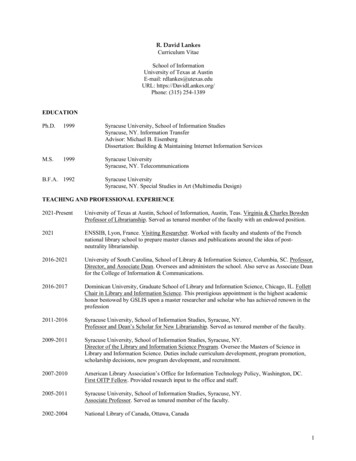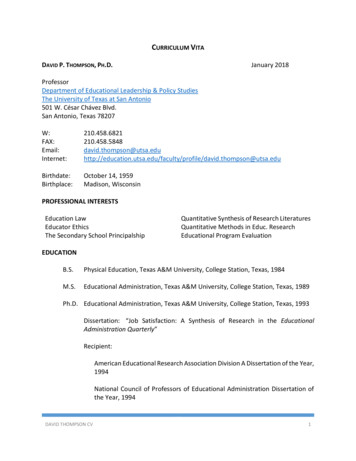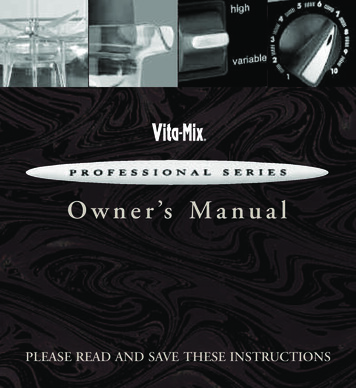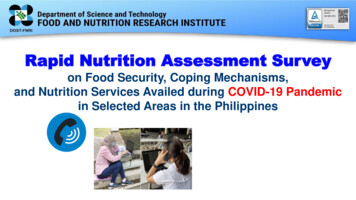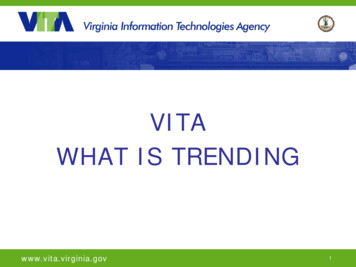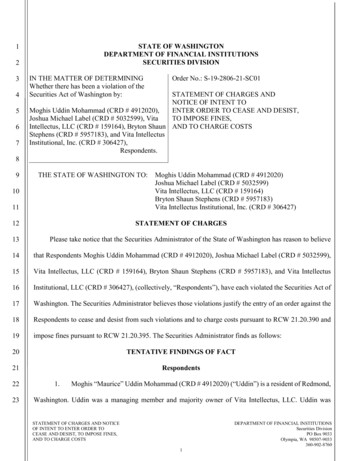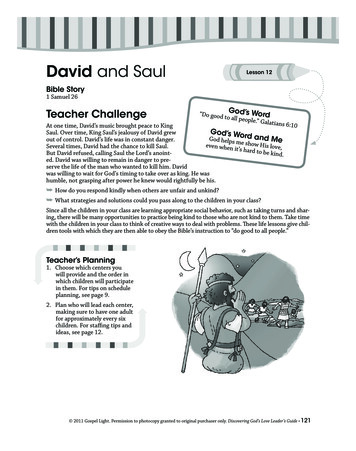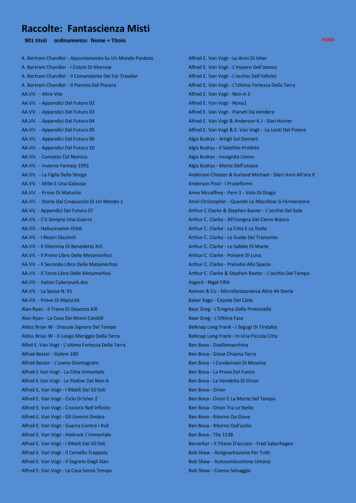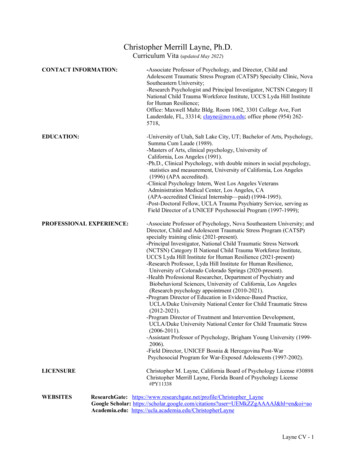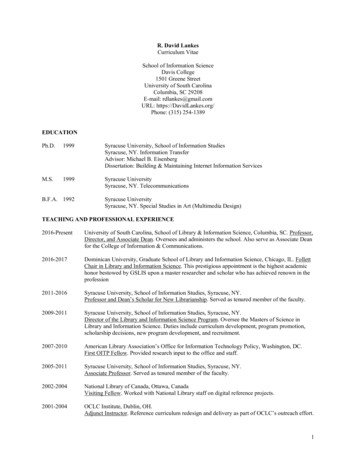
Transcription
R. David LankesCurriculum VitaeSchool of Information ScienceDavis College1501 Greene StreetUniversity of South CarolinaColumbia, SC 29208E-mail: rdlankes@gmail.comURL: https://DavidLankes.org/Phone: (315) 254-1389EDUCATIONPh.D.1999Syracuse University, School of Information StudiesSyracuse, NY. Information TransferAdvisor: Michael B. EisenbergDissertation: Building & Maintaining Internet Information ServicesM.S.1999Syracuse UniversitySyracuse, NY. TelecommunicationsB.F.A. 1992Syracuse UniversitySyracuse, NY. Special Studies in Art (Multimedia Design)TEACHING AND PROFESSIONAL EXPERIENCE2016-PresentUniversity of South Carolina, School of Library & Information Science, Columbia, SC. Professor,Director, and Associate Dean. Oversees and administers the school. Also serve as Associate Deanfor the College of Information & Communications.2016-2017Dominican University, Graduate School of Library and Information Science, Chicago, IL. FollettChair in Library and Information Science. This prestigious appointment is the highest academichonor bestowed by GSLIS upon a master researcher and scholar who has achieved renown in theprofession2011-2016Syracuse University, School of Information Studies, Syracuse, NY.Professor and Dean’s Scholar for New Librarianship. Served as tenured member of the faculty.2009-2011Syracuse University, School of Information Studies, Syracuse, NY.Director of the Library and Information Science Program. Oversee the Masters of Science inLibrary and Information Science. Duties include curriculum development, program promotion,scholarship decisions, new program development, and recruitment.2007-2010American Library Association’s Office for Information Technology Policy, Washington, DC.First OITP Fellow. Provided research input to the office and staff.2005-2011Syracuse University, School of Information Studies, Syracuse, NY.Associate Professor. Served as tenured member of the faculty.2002-2004National Library of Canada, Ottawa, CanadaVisiting Fellow. Worked with National Library staff on digital reference projects.2001-2004OCLC Institute, Dublin, OH.Adjunct Instructor. Reference curriculum redesign and delivery as part of OCLC’s outreach effort.1
2001-2002Upstate Medical University, College of Health Professions, Syracuse, NY.Adjunct. Worked with faculty to create joint research programs in technology, education andpublic health information.2000-2001Harvard University, School of Education, Cambridge, MA.Visiting Scholar. Worked with the Gutman Library on library and education research.2000Syracuse University, Syracuse, NY.Faculty Technology Associate. Worked with Faculty Computing to organize and deliver facultydevelopment programs.1998-2005Syracuse University, School of Information Studies, Syracuse, NY.Assistant Professor. Served as tenure track member of the faculty.1998-2016Information Institute of Syracuse, Syracuse, NY.Executive Director. Set policy and manage a research institute that has included the ERICClearinghouse on Information & Technology, AskERIC, the Gateway to Educational Materials,the Virtual Reference Desk and others. Sponsors have included the U.S. Department of Education,MCI/WorldCom, ATT, Microsoft, AASL, NSF, IMLS, ALA, The John D. & Catherine T.MacArthur Foundation.1996-1998Information Institute of Syracuse, Syracuse, NY.Associate Director. Set policy and managed a major research institute at Syracuse University.1997University of North Carolina, Chapel Hill, Chapel Hill, NC.Adjunct Faculty. Taught INLS 110-82, Information Reporting and Presentation (Summer).1996Syracuse University, School of Information Studies, Syracuse, NY.Adjunct Faculty. Taught IST 600, Building and Managing Internet Services (Spring), DesigningMultimedia with the Internet (Summer 1996).1992-1995Syracuse University, School of Information Studies, Syracuse, NY.Instructor and Teaching Assistant. Developed and co-taught a new graduate course, IST 600,Building and Managing Internet Services (Summer, 1994).1992-1995AskERIC, ERIC Clearinghouse on Information & Technology, Syracuse, NY.Coordinator Research & Development. Co-creator of the AskERIC project with Mike Eisenberg.PUBLICATIONSJournal Articles and Special IssuesFreeburg, D. & Lankes, R. David (2019). Special issue: Knowledge school within an historical context. Journal ofNew Librarianship. Volume 4, Special. Available: https://www.newlibs.org/issue/1623Lankes, R. David (2019). Why Do We Need a New Librarianship? Journal of New Librarianship. Volume 4,Special. Available: https://doi.org/10.21173/newlibs/7/3Lankes, R. David (2019). Forget the future: Our time is now. Journal of New Librarianship. Volume 4, Special.Available: https://doi.org/10.21173/newlibs/7/2Lankes, R. David (2019). Eulogy for the Information Age: The future is impact not access. Journal of NewLibrarianship. Volume 4, Special. Available: https://doi.org/10.21173/newlibs/7/82
Walter, S. & Lankes, R. David (2015). The Innovation Agenda. College & Research Libraries. 76(7). l.pdf htmlLankes, R. David, Stephens, M. & Arjona, M. (2015). Participatory and Transformative Engagement In LibrariesAnd Museums: Exploring And Expanding The Salzburg Curriculum. Volume 56, Supplement 1. Journal ofEducation for Library and Information Science. Available: /view/1323Lankes, R. David (Summer, 2012). Libraries are Obsolete. OLA Quarterly 18(2). [Available athttp://www.olaweb.org/assets/documents/olaq 18no2.pdf].Lankes, R. David (February, 2012). Joining the Conversation: School Librarian as Facilitators of Learning. Teacher Librarian. 39(3), 8-12.Stanton, J. M., Kim, Y., Oakleaf, M., Lankes, R. D. Gandel, P., Cogburn, D. & Liddy, E. D. (June 2011). Educationfor eScience Professionals: Job Analysis, Curriculum Guidance, and Program Considerations. Journal ofEducation in Library and Information Science. 52(2).Lankes, R. David (2008). Extending the conversations at the department of justice. Conversants, 1. [Available s, R. David (2008). Collecting conversations in a massive scale world. Library Resources & TechnicalServices, 52(2), 12-18.Lankes, R. David (2008). The ethics of participatory librarianship. Journal of Library Administration, 47(3/4), 233241. Also published in Besnoy, A. L. (2009). Ethics and integrity in libraries. London: Routledge.Lankes, R. David (2008). Credibility on the Internet: Shifting from authority to reliability. Journal ofDocumentation, 64(5), 667-686. - 2009 Literati Outstanding Paper AwardLankes, R. David, Silverstein, J.L., Nicholson, S., & Marshall, T. (2007). Participatory networks: The library asconversation. Information Research, 12(4). [Available at ].Lankes, R. David, Silverstein, J.L., Nicholson, S. (2007). Participatory networks: The library as conversation.Information Technology and Libraries, 26(4), 17-33.Nicholson, S. & Lankes, R. David (2007). The Digital Reference Electronic Warehouse (DREW) project: Creatingthe infrastructure for digital reference research through a multi-disciplinary knowledge base. Reference andUser Services Quarterly, 46(3), 45-59.Lankes, R. David, Gross, M., & McClure, C.R. (2006). Costing reference: Issues, approaches, and directions forresearch. The Reference Librarian, 46(95/96), 171-184.Lankes, R. David (2005). Digital reference research: Fusing research and practice. Reference and User ServicesQuarterly, 44(4), 320-326.Lankes, R. David (2004). The digital reference research agenda. Journal of the American Society for InformationScience and Technology, 55(4), 301-311.Pomerantz, J., Nicholson, S., Belanger, Y., & Lankes, R. David (2004). The current state of digital reference:Validation of a general digital reference model through a survey of digital reference services. InformationProcessing & Management, 40(2), 347-363.Lankes, R. David (2003). Current state of digital reference in primary and secondary education. D-Lib Magazine,9(2), 21.3
Pomerantz, J., Nicholson, S., & Lankes, R. David (2003). Digital reference triage: An investigation using the DelphiMethod into the factors influencing question routing and assignment. The Library Quarterly, 73(2), 103120.Lankes, R. David & Bonner, H. (2003). Building an education infrastructure for allied health. Journal of AlliedHealth, 32(1), 32-37.Lankes, R. David, Gross, M., & McClure, C. (2003). Cost, statistics, measures, and standards for digital referenceservices: A preliminary view. Library Trends, 51(3), 410-413.Belanger, Y.M., Lankes, R. David, & Shostack, P.L. (2003). Managing data collection for real time reference:Lessons from the AskERIC Live! experience. Internet Reference Services Quarterly, 8(1/2), 137-149.Lankes, R. David (2002/2003). The digital reference fallacy. Co-published simultaneously in Bill Katz (Ed.), DigitalReference Services, New York: Hawthorn Press, Inc.; and The Reference Librarian, 79/80, 35-44.Lankes, R. David & Shostack, P. (2002). The necessity of real-time: Fact and fiction in digital reference systems.Reference and User Services Quarterly, 41(4), 350-355.Kasowitz, A., Bennett, B., & Lankes, R. David (2000). Quality standards for digital reference consortia. Referenceand User Services Quarterly, 39(4), 355-363.Lankes, R. David (Ed.). (2000). The birth cries of digital reference [special section]. Reference and User ServicesQuarterly, 39(4), 352-390.Lankes, R. David & Sutton, S.A. (1999). Developing a mission for the national education network: The challenge ofseamless access. Government Information Quarterly, 16(2), 169-181.Lankes, R. David (1999). AskA’s: Lesson learned from k-12 digital reference services. Reference & User ServicesQuarterly, 38(1), 63-71.Lankes, R. David (1997). Digital reference on the Internet. Internet Research, 7(4), 342-346.Lankes, R. David (1995). AskERIC and the virtual library: Lessons for emerging digital libraries. Internet Research5(1), 56.Nilan, M.S., Silverstein, J.L. & Lankes, R. David (1992). The VR technology agenda in medicine. Nilan, MichaelS., Virtual Reality 93 Special Report, 33-37.Peer Reviewed ProceedingsKim, Y., Zhang, P., & Lankes, R. David (2009). Future of Information Seeking on the Internet and WebAdvertising: How Can We Guide Web Advertising. [Available al-Ver21.doc].Lankes, R. David, Cogburn, D., Oakleaf, M., & Stanton, J. (2008). Cyberinfrastructure facilitators: New approachesto information professionals for e-Research. Oxford e-Research Conference. [Available d9f-40b0-822f-269332643e6b].Lankes, R. David (2004). The roles of digital reference in a digital library environment. In Zhan Furui (Ed.), Theproceedings of digital library – advance the efficiency of knowledge utilization. (pp. 262-274). Beijing,China: Scientific and Technical Documents Publishing House.4
Pomerantz, J., & Lankes, R. David (2003). Taxonomies for automated question triage in digital reference. In C. C.Marshall, G. Henry & L. Delcambre (Eds.), Proceedings of the 2003 joint conference on digital libraries,May 27-31 2003, Rice University, Houston, TX. (pp. 119-121). Washington DC: IEEE Computer Society.Lankes, R. David & McClure, C., & Gross, M. (2001). Assessing quality in digital reference services. In 2001proceedings of the 64st annual meeting. (pp. 323-329). Silver Spring, MD: The American Society forInformation Science.Wasik, Joann M., Lankes, R. David (1999). The virtual reference desk: Supporting education through a network ofhuman expertise. In Nixon, C. and Burmood, J. (Eds.), Internet librarian 99: Proceedings of the thirdInternet librarian conference. (pp. 198-202). Medford, NJ: Information Today.Lankes , R. David (1998). The virtual reference desk: Building human expertise into information systems. InPreston, C. (Ed.), 1998 proceedings of the 61st annual meeting (vol. 35). (pp. 81-90). Silver Spring, MD:The American Society for Information Science.Sutton , Stuart A., Lankes, R. David, Small , Ruth, & Eisenberg , Michael (1998). Networked information discoveryand retrieval for educational materials on the Internet: Metadata development, deployment, and evolution.In Preston, C. (Ed.), 1998 proceedings of the 61st annual meeting (vol. 35). (pp. 54-62). Silver Spring, MD:The American Society for Information Science.BooksLankes, R. David (2016). The New Librarianship Field Guide. Cambridge, Ma: MIT PressLankes, R. David (2014). The Boring Patient. Jamesville, NY: Riland Publications.Lankes, R. David (2012). Expect More: Demanding Better Libraries For Today's Complex World. Jamesville, NY:Riland Publications. (also available as an audio book). 2nd Edition 2016. Translations: Spanish, Portuguese,German, French (Exigeons de meilleures bibliothèques by Ateliers de [sens public])Lankes, R. David (2011). The Atlas of New Librarianship. Cambridge, Ma: MIT Press. – 2012 ABCCLIO/Greenwood Award for the Best Book in Library Literature. Translations: Italian [L'atlante dellabiblioteconomia moderna].Radford, M. & Lankes, R. David (Eds.) (2010). Reference renaissance: Current and future trends. New York: NealSchuman Publishers.Lankes, R. David (2009). New concepts in digital reference. San Rafael, CA: Morgan-ClaypoolMcClure, C., Lankes, R. David, Gross, M., & Choltco-Devlin, B. (2007). Statistics, measures and quality standardsfor assessing digital reference library services: Guidelines and procedures. Beijing: Beijing Library Press.(also translated into Arabic)Lankes, R. David, Westbrook, L., Nicholson, S., Radford, M., & Silverstein, J. (Eds.). (2007).Virtual referenceservice: From competencies to assessment. New York: Neal-Schuman Publishers.Lankes, R. David, Abels, E., White, L., & Haque, S. (Eds.). (2005). Creating a reference future. New York: NealSchuman Publishers.Lankes, R. David, Janes, Joseph, Smith, Linda C., & Finneran, Christina M. (Eds.). (2004). The virtual referenceexperience: Integrating theory into practice. New York: Neal-Schuman Publishers.Lankes, R. David, Goodrum, A., & Nicholson, S. (Eds.). (2003). The digital reference research agenda. Chicago:Publications In Librarianship, Association of College & Research Libraries.5
McClure, C., Lankes, R. David, Gross, M., & Choltco-Devlin, B. (2002). Statistics, measures and quality standardsfor assessing digital reference library services: Guidelines and procedures. Syracuse: ERIC Clearinghouseon Information & Technology.Lankes, R. David, McClure, C., Gross, M., & Pomerantz, J. (Eds.). (2002). Implementing digital reference services:Setting standards and making it real. New York: Neal-Schuman Publishers. Also published by FacetPublishing, the publisher of the UK Library Association.Lankes, R. David, Collins, J. & Kasowitz, A. S. (2001). Digital reference services in the new millennium. NewYork: Neal-Schuman. Also published by Facet Publishing, the publisher of the UK Library Association.Lankes, R. David (1998). Building & maintaining Internet information services: K-12 digital reference services.Syracuse: ERIC Clearinghouse on Information & Technology.Lankes, R. David & Kasowitz , A. S. (1998). AskA starter kit: How to build and maintain digital reference services.Lanham: Scarecrow Press.Lankes, R. David (1998). Building & maintaining Internet information services. Dissertation, Syracuse University.Lankes, R. David (1996). The bread and butter of the Internet: A primer and presentation packet for educators.Syracuse: ERIC Clearinghouse on Information & Technology.Book ChaptersLankes, R. David (2011). Forward. In Fontichiaro, K. and Hamilton, B. (Eds.), School libraries ebook project.Available: JaKfMIQjgyNl8fSPEaQYF1TTnTLQ/edit?hl en USLankes, R. David (2010). Innovators wanted: No experience necessary? In Walter,, & Williams (Eds.), The expertlibrary: Sustaining, staffing, and advancing the academic library in the 21st century. Association ofCollege & Research Libraries.Lankes, R. David & Jureller, P. (2010). Conversations and the true knowledge of generations. In Rothstein & Schull(Eds.), Longevity and libraries: Unexpected voices. American Library Association.Lankes, R. David (2010). Setting Sail with Map in Hand. In Radford, M. & Lankes, R. David (Eds.). Referencerenaissance: Current and future trends. Neal-Schuman Publishers.Lankes, R. David (2008). Trusting the Internet: New approaches to credibility tools. In M.J. Metzger & A.J.Flanagin (Eds.), Digital media, youth, and credibility. The John D. and Catherine T. MacArthur FoundationSeries on Digital Media and Learning. (pp. 101-122). Cambridge, MA: The MIT Press. doi:10.1162/dmal.9780262562324.101.Nicholson, S. & Lankes, R. David (2005). The Digital Reference Electronic Warehouse (DREW) project: Creatingthe infrastructure for digital reference research through a multi-disciplinary knowledge base. In Lankes,Abels, White, & Haque (Eds.), Creating a reference future. New York: Neal-Schuman Publishers, Inc.Lankes, R. David (2003). Digital reference. In M. Drake (Ed.), Encyclopedia of library and information science. (2nded.). New York: Marcel Dekker, Inc.Lankes, R. D. (2002). Virtual service. In M. Melling & J. Little (Eds.), Building a successful customer-serviceculture: A guide for library and information managers. London, UK: Library Association Publishing.Lankes, R. David (2002). Emerging standards for digital reference: The question interchange profile. In R. D.Lankes, C. McClure, M. Gross & J. Pomerantz (Eds.), Implementing digital reference services: Settingstandards and making it real. New York: Neal-Schuman Publishers, Inc.6
Gross, M., McClure, C. & Lankes, R. David (2002). Assessing quality in digital reference services: An overview ofthe key literature in digital reference. In R. D. Lankes, C. McClure, M. Gross & J. Pomerantz (Eds.),Implementing digital reference services: Setting standards and making it real. New York: Neal-SchumanPublishers, Inc.Lankes, R. David (2002). Assessing quality in digital reference services: Preliminary findings. In R. D. Lankes, C.McClure, M. Gross & J. Pomerantz (Eds.), Implementing digital reference services: Setting standards andmaking it real. New York: Neal-Schuman Publishers, Inc.Lankes, R. David (2001). Assessing the provision of networked services: ERIC as an example. In C. McClure & J.C.Bertot (Eds.), Evaluating networked information services: Techniques, policy and issues. Medford, N.J.:Information Today.Lankes, R. David (2000). The growing support crisis in federal STI. In P.D. Fletcher & J.C. Bertot (Eds.), Worldlibraries on the information superhighway : Preparing for the challenges of the next millennium. Hershey,PA: Idea Group Publishing.Lankes, R. David (1997). Building the virtual reference desk. In B. Collis & G. Knezek (Eds.), Teaching & learningin the digital age: Research into practice with telecommunications in educational settings. (pp. 119-128).University of North Texas, Denton, TX: TCET.Small, R. & Lankes, R. David (1996). Motivating students. In L. Lambert, S. Tice, & P. Featherstone (Eds.),University teaching: A guide for graduate students. Syracuse, NY: Syracuse University Press.Juried PostersNicholson, S., & Lankes, R. David (2005, 7-11 July). DREW: Digital reference electronic warehouse. Posterpresented at the Joint Conference on Digital Libraries, Denver, CO.Pomerantz, J., & Lankes, R. David (2002, 14-18 July). Integrating expertise into the NSDL: Putting a human faceon the digital library. Poster presented at the Joint Conference on Digital Libraries, Portland, OR.Research Reports and White PapersLankes, R. David (2015). Expect more: Why libraries cannot become STEM educators. For the Public Libraries &STEM Conference. [Available ference/events/Lankes Expect More PRINT.pdf].Lankes, R. David (2008). The future of libraries and librarians in a democracy. For the John D. and Catherine T.MacArthur Foundation.Lankes, R. David, Silverstein, J. L., & Nicholson, S. (2007). Participatory networks: The library as conversation.For the American Library Association’s Office of Information Technology Policy [Available orks.pdf].Lankes, R. David (2002). Impact and opportunity of digital reference in primary and secondary education. For theHarvard University Digital Reference Research Symposium.Silverstein, J. L., Pomerantz, J. & Lankes, R. David (2001). Digital reference at the U.S. Department of Education:Implications for digital reference software tools. For the U.S. Department of Education.Silverstein, J. L. & Lankes, R. David (1999). Digital reference services and centers at the United States Departmentof Education: Analysis and recommendations. For the U.S. Department of Education.7
Lankes, R. David (1999). The Virtual Reference Desk: Question interchange profile. For the Virtual ReferenceDesk.Lankes, R. David (1999). Adjuncts, affiliates and partners: Building an ERIC network for the 21st century. Paperpresented to the ERIC Directors.Lankes, R. David (1998). The Virtual Reference Desk: Building a network of expertise for America's schools. WhitePaper for the Virtual Reference Desk. ERIC Clearinghouse on Information & Technology; Syracuse, NY.ED417728.Lankes, R. David & Kasowitz, A. (1998). Virtual Reference Desk AskA software: Decision points and scenarios.Paper presented to the ERIC Directors.Lankes, R. David (1997). Building the Virtual Reference Desk. White Paper for the Virtual Reference Desk.Lankes, R. David & Nilan, M. S. (1994). SonicScreen: Use of alternate modalities in the user interface. For the U.S.Air Force Office of Scientific Research.Nilan, M. S. & Lankes, R. David (1992). User-Based requirements for large-scale distributed informationmanagement systems: Representation for system designers. For the Rome Laboratory/Air Force Office ofScientific Research.Other Invited PublicationsLankes, R. David (July, 2017). “New Librarianship.” BuB. Forum Bibliothek und Information“ 69 -07/2017 (S.400403) [in German translated from an English text]Lankes, R. David (March, 2010) "Ereaders, the iPad—Is That All There Is?" School Library Journal. cle/CA6723753.html].Lankes, R. David (Spring 2009). A Sparrow with a Machine Gun. netConnect: Data in Context supplement toLibrary Journal. [available ml].Gandel, P.B., Oakleaf, M., Stanton, J.M., Lankes, R. David, Cogburn, D.L., & Liddy, E.D. (2009). More people, notjust more stuff: Developing a new vision for research cyberinfrastructure, Research Bulletin, 2. [Availableat http://www.educause.edu/].Lankes, R. David. (2008, December/January). Virtual reference to participatory librarianship: Expanding theconversation. ASIS&T Bulletin. [Available at ankes, R. David (2007, September). Library association 2.0. Searcher Magazine.Lankes, R. David and Nicholson, S. (2005). Reference extract: Extending the reach of digital reference throughcollaborative data warehousing. IEEE Technical Committee on Digital Libraries Bulletin 2(1). [Availableat n/nicholson.html].Lankes, R. David (2002). Introduction: I want my flying car. In R. D. Lankes, C. McClure. M. Gross & J. Pomerantz(Eds.), Implementing digital reference services: Setting standards and making it real. New York: NealSchuman Publishers, Inc.Lankes, R. David (2000). Grabbing ERIC by the tail: Introducing the ERIC commissioned papers. GovernmentInformation Quarterly, 18(1), 3-4.Lankes, R. David (1998, November/December). Synthesis tools I. The Big6 Newsletter: Teaching Technology andInformation Skills, 2(2),12-13.8
Lankes, R. David (1998, July/August). A hyperfiction continuum. The Big6 Newsletter: Teaching Technology andInformation Skills, 1(6), 12-15.Lankes, R. David (1998, May/June). Presenting a good image. The Big6 Newsletter: Teaching Technology andInformation Skills, 1(5), 12-13.Lankes, R. David (1998, March/April). Real time messaging for collaboration. The Big6 Newsletter: TeachingTechnology and Information Skills, 1(4), 12-13.Lankes, R. David (1998, January/February). AskA services. The Big6 Newsletter: Teaching Technology andInformation Skills, 1(3), 12-13.Lankes, R. David (1997, November/December). Web authoring. The Big6 Newsletter: Teaching Technology andInformation Skills, 1(1), 12-15.Lankes, R. David (1997, September/October). Intranets. The Big6 Newsletter: Teaching Technology andInformation Skills, 1(1), 10-15.Lankes, R. David (1997). Build a World Wide Web commerce center. Internet Research, 7(4), 51-52.Lankes, R. David (1997, January). The bread and butter of the Internet: A primer and presentation packet foreducators. ERIC Digest.Lankes, R. David (1996, March). New toys and trends for the Internet. Information Searcher, 8(2), 1-9.Lankes, R. David (1996, January). The World Wide Web or do spiders really surf? Information Searcher, 8(1), 1-8.Lankes, R. David (1995). Gopher: What if the world was one big menu?” Information Searcher, 7(4), 3-5.Lankes, R. David (1995). Telnet and FTP: The Internet's forgotten heroes. Information Searcher, 7(3), 16-19.Lankes, R. David (1995). E-Mail: The Net's common currency. Information Searcher, 7(2), 6-9.Lankes, R. David (1995). The Internet model. Information Searcher, 7(1), 3-6.Lankes, R. David (1993). AskERIC: The virtual librarian. Information Searcher, 6(1), 20-22.FUNDED RESEARCH AND DEVELOPMENT ACTIVITIES2017-PresentLibrary Scholars, Various. PI. Built school library cohort programs with South Carolina Schooldistricts to transition classroom teachers to school librarians. 500,0002015-2016Community as Collection: Building the Community Profile System, IMLS. Co-PI. A three-yearinvestigation into building a community profile system to allow libraries to better connect tocommunity expertise. 281,0002015-PresentExpect More Collaboratory, Various. PI. A two-year collaborative effort to develop advocacy andtraining materials for librarians and libraries based on the Expect More book. 63,0002014-2016Design On Learning: 21st Century Online Learning For Library Workers, IMLS. Co-PI. A threeyear continuing education (CE) development and implementation partnership project among SouthCentral Regional Library Council, Syracuse University’s School of Information Studies, and theNY 3Rs Association, Inc. Design on Learning will 1) enable librarian-trainer participants tosuccessfully transfer their in-person teaching skills/pedagogy to the online environment; 2) enablelibrarian-trainers to evaluate and gain experience with various delivery platforms; and 3) teachlibrary workers to learn effectively in the online environment.9
2012-2015Project ILEAD USA, IMLS. Chair of the Instructor Corps. A three-year continuing educationinitiative that directly addresses the need to expand librarians’ leadership abilities to useparticipatory technology to effectively engage their libraries’ constituents. The primary goals ofthis project are 1) to help library staff understand and respond to user needs through theapplication of participatory technology tools, and 2) the creation of an easy-to-replicate modelprogram. 470,0002012-2013Cyber Security and Information Systems, U.S. Department of Defense. Researcher. AssistQuanterion, as it operates the CSIAC, in developing a community of practice platform. 307,0002012-2014Developing the Salzburg Curriculum, IMLS and The Global Salzburg Seminar. PrincipalInvestigator. Develop a high-level curriculum framework for librarians and museumprofessionals and then map it to relevant curricula and standards. 10,0002010-2012DACS – Digital Library Research, U.S. Department of Defense. Principal Investigator forDigital Library Portion. Assist Quanterion, as it operates the DACS, in identifying,recommending, and applying technologies and techniques, particularly automated techniques, forefficiently identifying, collecting, cataloging, and aggregating electronic information resources intargeted focal software related technology areas. 646,8442010-2011Reference Extract, John D. and Catherine T. MacArthur Foundation. Co-Principal Investigator.First phase of development for Reference Extract, a credibility engine, allowing users to embedthe credibility judgments of librarians worldwide into their applications. 350,0002009-2012Project ILEAD U, IMLS. Chair of the Instructor Corps. A three-year continuing educationinitiative that directly addresses the need to expand librarians’ leadership abilities to useparticipatory technology to effectively engage their libraries’ constituents. The primary goals ofthis project are 1) to help library staff understand and respond to user needs through theapplication of participatory technology tools, and 2) the creation of an easy-to-replicate modelprogram. 418,6582008-2009Reference Extract Planning Grant, John D. and Catherine T. MacArthur Foundation. PrincipalInvestigator. Investigated and developed a business plan and technical architecture for a generalpurpose search engine built around credible communities (initially reference librarians). 97,4282008Future of Libraries, John D. and Catherine T. MacArthur Foundation. Consultant. Prepared areport on the area of libraries and their future evolution. 2,5002008-2011CI-Facilitators: Accelerating Knowledge Development and Collaboration across the STEMDisciplines, NSF. Co-Principal Investigator. Developing a curriculum to train cyberinfrastructure facilitators to aid in the adoption of technologies to further e-science. 239,9452007-2010A Virtual Learning Laboratory for Digital Reference: Transforming the Internet Public Library,IMLS. Consultant. Enhancing the Internet Public Library to make digital reference learningobjects ava
Associate Director. Set policy and managed a major research institute at Syracuse University. 1997 University of North Carolina, Chapel Hill, Chapel Hill, NC. Adjunct Faculty. Taught INLS 110-82, Information Reporting and Presentation (Summer). 1996 Syracuse University, School of Information Studies, Syracuse, NY. Adjunct Faculty.
![No, David! (David Books [Shannon]) E Book](/img/65/no-20david-20david-20books-20shannon-20e-20book.jpg)
